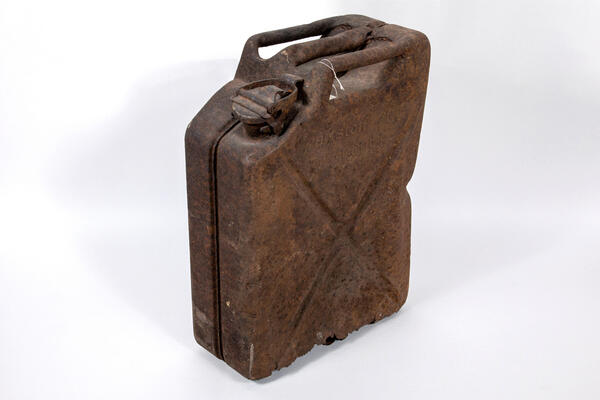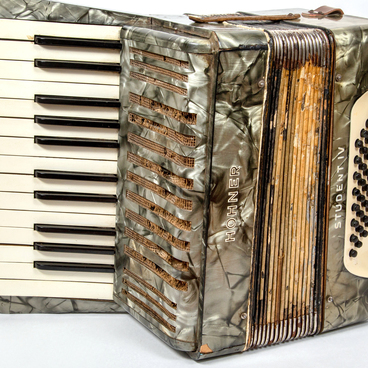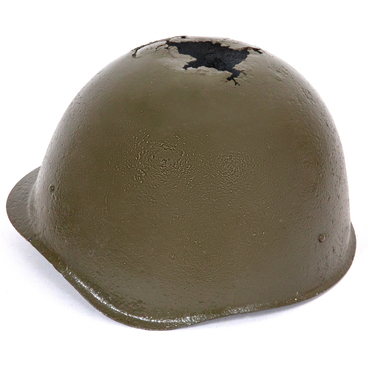This jerry can was found during excavations at the battlefields of the Great Patriotic War in the Nelidovsky district, Tver Oblast. Natalia Usenko, leader of the Noyabrsk joint search party ‘Vitalis’, transferred it to the museum. This can is an early model of the jerry can, as it does not have its characteristic feature — the rounded rectangular cross section in the center.
The Wehrmacht ground forces did not have gas tankers or tank trucks. Fuel was transported by trucks in heavy 20-liter cans. The cars had to be refueled manually. One German tank needed 27 canisters of fuel, and after a full refueling, the tanks could be driven only for 80-100 kilometers.
In November 1936, the German army started to intensively form motorized divisions. The Wehrmacht command announced a tender for the development of a new container designed for storing and transporting fuel. As a part of the tender, the Schwelmer Eisenwerk Müller Company in Schwelm developed the revolutionary canister design.
The new container weighed only four kilograms and had a 20-liter capacity. It was made of two stamped steel plates, which were welded together. It had a recessed welded seam so that it would not protrude and would not damage other canisters when transported stacked. The cross-shaped stamping on the sides strengthened the can, and the rounded corners reduced the likelihood of damaging the container.
Three handles were on each canister so that it could be carried by two people, or two cans could be carried by one person in each hand. In addition, it was easy to move it along a chain. The lid with a rubber gasket reliably protected the container from leaks.
The canister has an air pocket to compensate for the changes in the volume of liquids during sharp temperature changes, for example, in frosts. The siphon tube equalized the pressure in the pocket with the pressure outside, and when the canister was opened, there was no fuel leakage. This tube also accelerated the process of emptying the canister when it was turned over.
The Schwelmer Eisenwerk Müller company launched the production of new cans in early 1937 in cooperation with the Ambi-Budd Presswerk company from Berlin, which had large production capacities. They produced such containers until 1944. The manufacturer’s branding, the volume, and the hazard warning were pressed or written with paint.
Since 1938, the Nowack company from Bautzen joined the production. The creation of a new type of canisters was carefully concealed. They began to be mass-supplied to the German army only by the end of 1940.
The Wehrmacht ground forces did not have gas tankers or tank trucks. Fuel was transported by trucks in heavy 20-liter cans. The cars had to be refueled manually. One German tank needed 27 canisters of fuel, and after a full refueling, the tanks could be driven only for 80-100 kilometers.
In November 1936, the German army started to intensively form motorized divisions. The Wehrmacht command announced a tender for the development of a new container designed for storing and transporting fuel. As a part of the tender, the Schwelmer Eisenwerk Müller Company in Schwelm developed the revolutionary canister design.
The new container weighed only four kilograms and had a 20-liter capacity. It was made of two stamped steel plates, which were welded together. It had a recessed welded seam so that it would not protrude and would not damage other canisters when transported stacked. The cross-shaped stamping on the sides strengthened the can, and the rounded corners reduced the likelihood of damaging the container.
Three handles were on each canister so that it could be carried by two people, or two cans could be carried by one person in each hand. In addition, it was easy to move it along a chain. The lid with a rubber gasket reliably protected the container from leaks.
The canister has an air pocket to compensate for the changes in the volume of liquids during sharp temperature changes, for example, in frosts. The siphon tube equalized the pressure in the pocket with the pressure outside, and when the canister was opened, there was no fuel leakage. This tube also accelerated the process of emptying the canister when it was turned over.
The Schwelmer Eisenwerk Müller company launched the production of new cans in early 1937 in cooperation with the Ambi-Budd Presswerk company from Berlin, which had large production capacities. They produced such containers until 1944. The manufacturer’s branding, the volume, and the hazard warning were pressed or written with paint.
Since 1938, the Nowack company from Bautzen joined the production. The creation of a new type of canisters was carefully concealed. They began to be mass-supplied to the German army only by the end of 1940.



